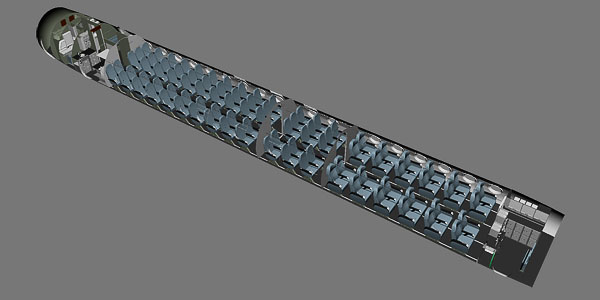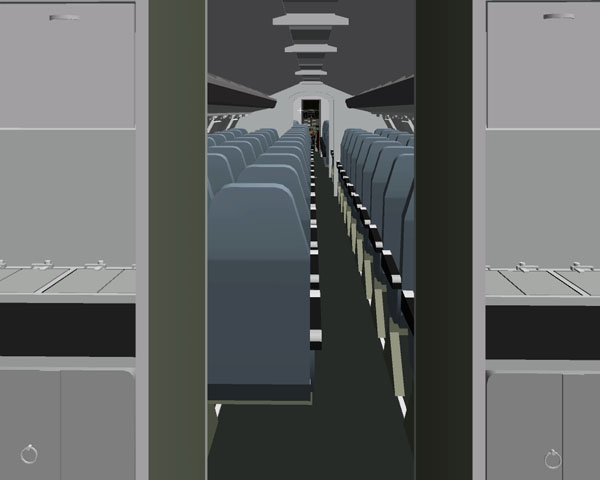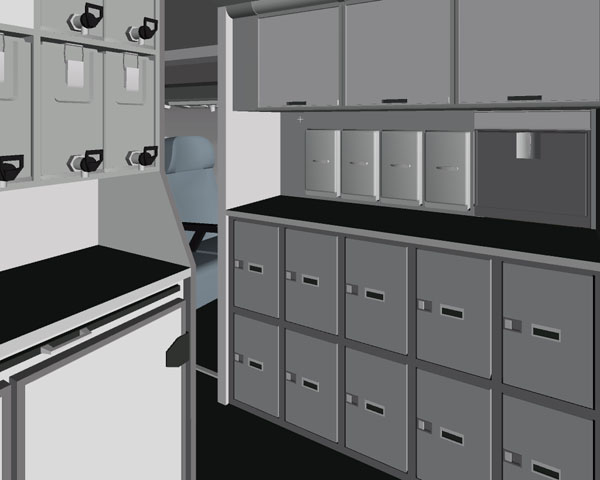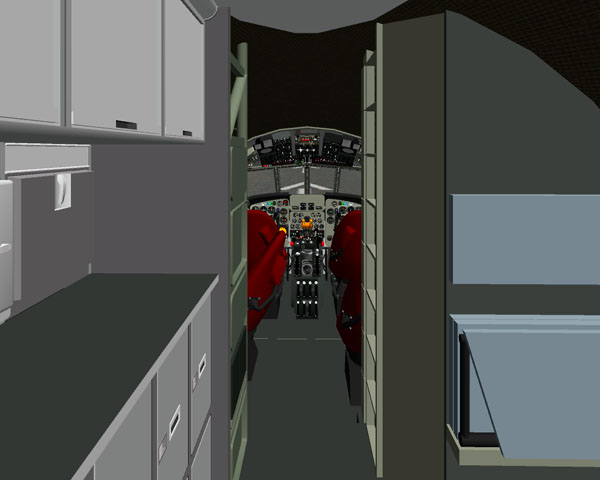Comet 4 Passenger Cabin
06/01/09 11:00

Passenger Cabin
Over the Christmas break, I finished modelling the whole passenger cabin, from the forward galley to the dome freight compartment. No realistic texturing yet, just a kind of painting by numbers; flat tones to give a sense of what it will be like.
The files are huge: 8.4MB for the interior alone. In spite of careful reduction of unnecessary detail and hidden surfaces, the whole package is now 58MB. While modern desktop computers won’t break into a sweat, older ones might, so I’m considering alternative object files for people to avoid flying in perpetual fog. For example, the huge seating file could be swapped for a simple closed door behind the galley.

Tourist Class seating was much more densely packed than the generous, thickly cushioned seats in First Class (see 28/12/2008). De Havilland recommended Microcell Traveller seats: triple units on the port side, and double units on the starboard side, leaving an extremely narrow aisle inbetween. Certainly not enough for a modern service trolley. By modern standards, the Comet was a small airliner. Even so, the space in Tourist Class was better than modern Economy Class. The width of the Microcell seat cushion was 17.5”, and the seat pitch was 34”. In 2008, the average Economy Class seat cushion was 17.2” wide, and the seat pitch was 31”. Low-cost airlines often have a pitch of only 29”. That makes 1960s Tourist Class more like modern long-haul Economy Class.

As with First Class, I believe few of these Microcell seats survive. In its original role as the world’s first trans-Atlantic jet airliner, so much of the payload was fuel that it could carry relatively few passengers, which is one of the reasons the space for each passenger was pretty good. When B.O.A.C. upgraded to brand new, larger, and more capable Boeing 707s in 1960, Comets stopped being used at maximum range, and tended to be used on shorter flights. It wasn’t the end of the Comet, by any means: a peculiarity of its original specification by the Brabazon Committee meant it had to be capable of landing at ordinary airports, not the vast new runways the 707 was designed for. As a result, the Comet’s final (and without doubt the longest) success was plying tourist routes in Europe for Dan Air, carrying less fuel but a greater number of passengers. Most of the original seats had to go so they could pack more people in.
Boarding was through a door on the port side aft, through the pantry (see 23/12/2008), and into the passenger compartment via Tourist Class (below).

The Galley was the larger of two kitchens, at the opposite (forward) end of the aircraft. The galley and the pantry were fabricated by Henshall & Sons, in Byfleet. In their hay-day, Comet galleys were equipped with a large L.E.C. fridge, G.E.C. ovens, heated food and drink containers, and a G.E.C. rapid water-heater, and a sink, fed from a 21 gallon fresh-water tank above the ceiling. Freshly prepared food was cooked and served to First Class passengers on real china, with proper cutlery. Tourist class food was pre-packed on moulded trays and loaded into heated units that plugged into the Henshall system. The pantry contained more of these hot-tray containers, and more heated drink containers and a second, 19-gallon fresh water tank.


At the forward end of the galley was another fold down bench and harness straps for two of the crew.


--
GMM-P (06/01/2009)
blog comments powered by Disqus
